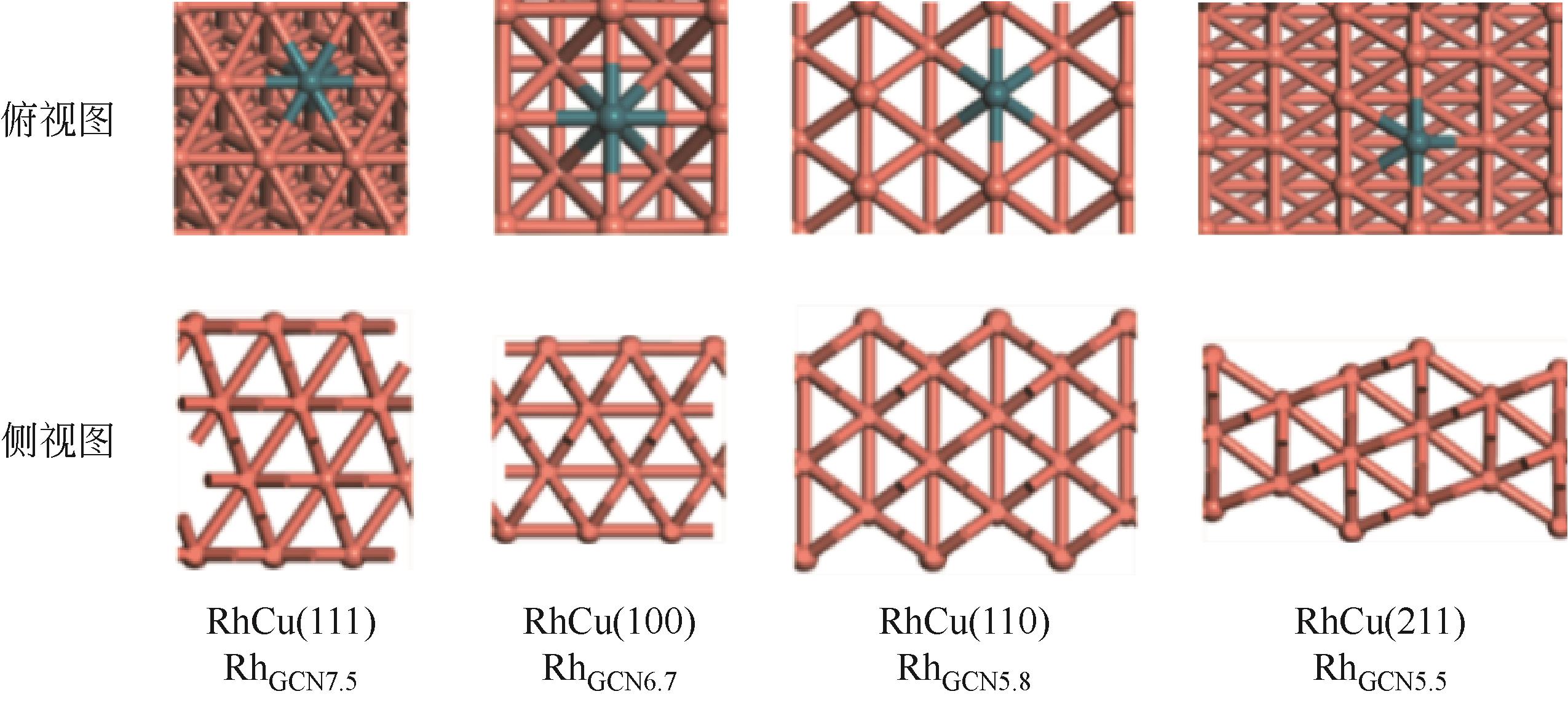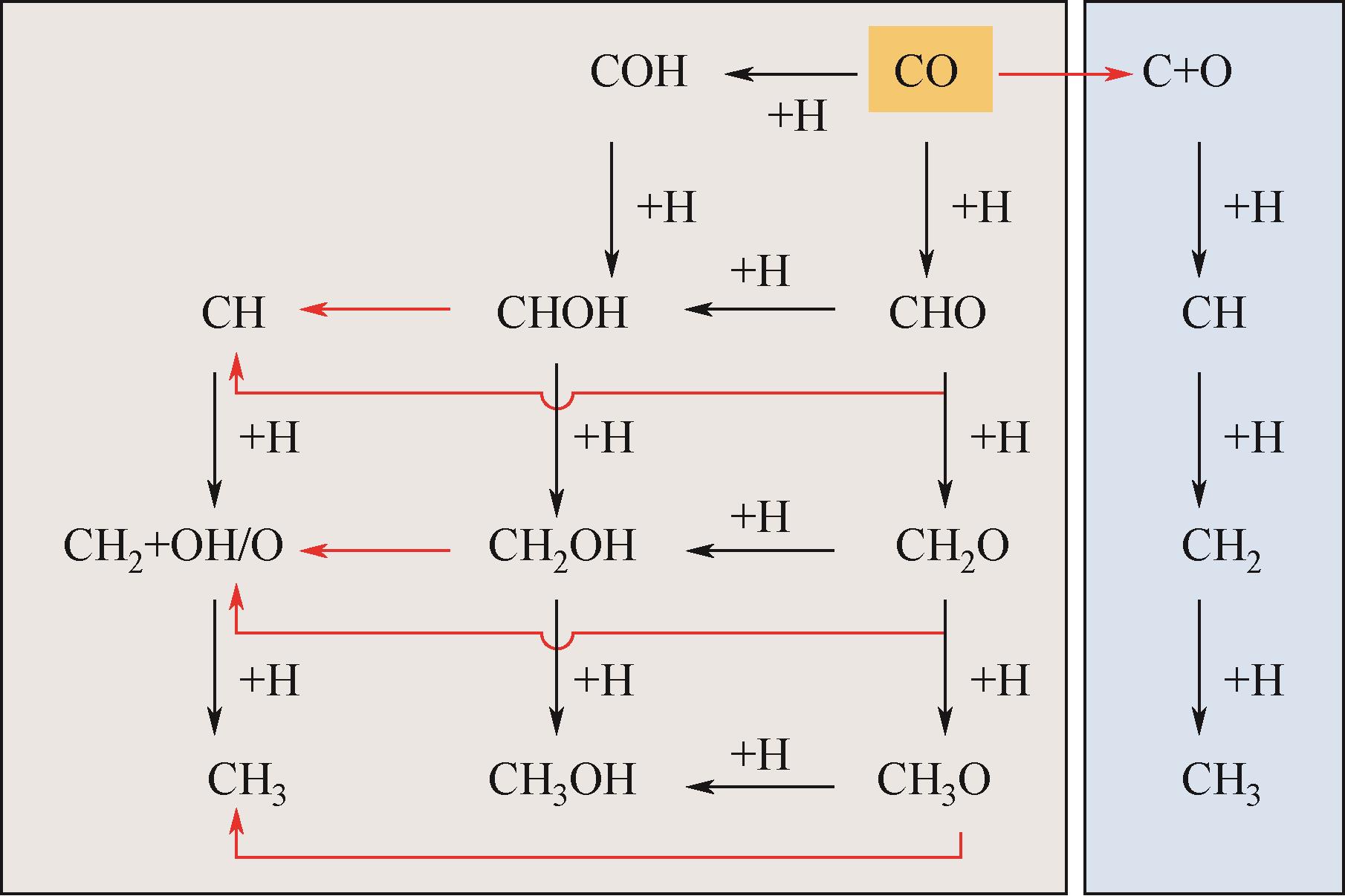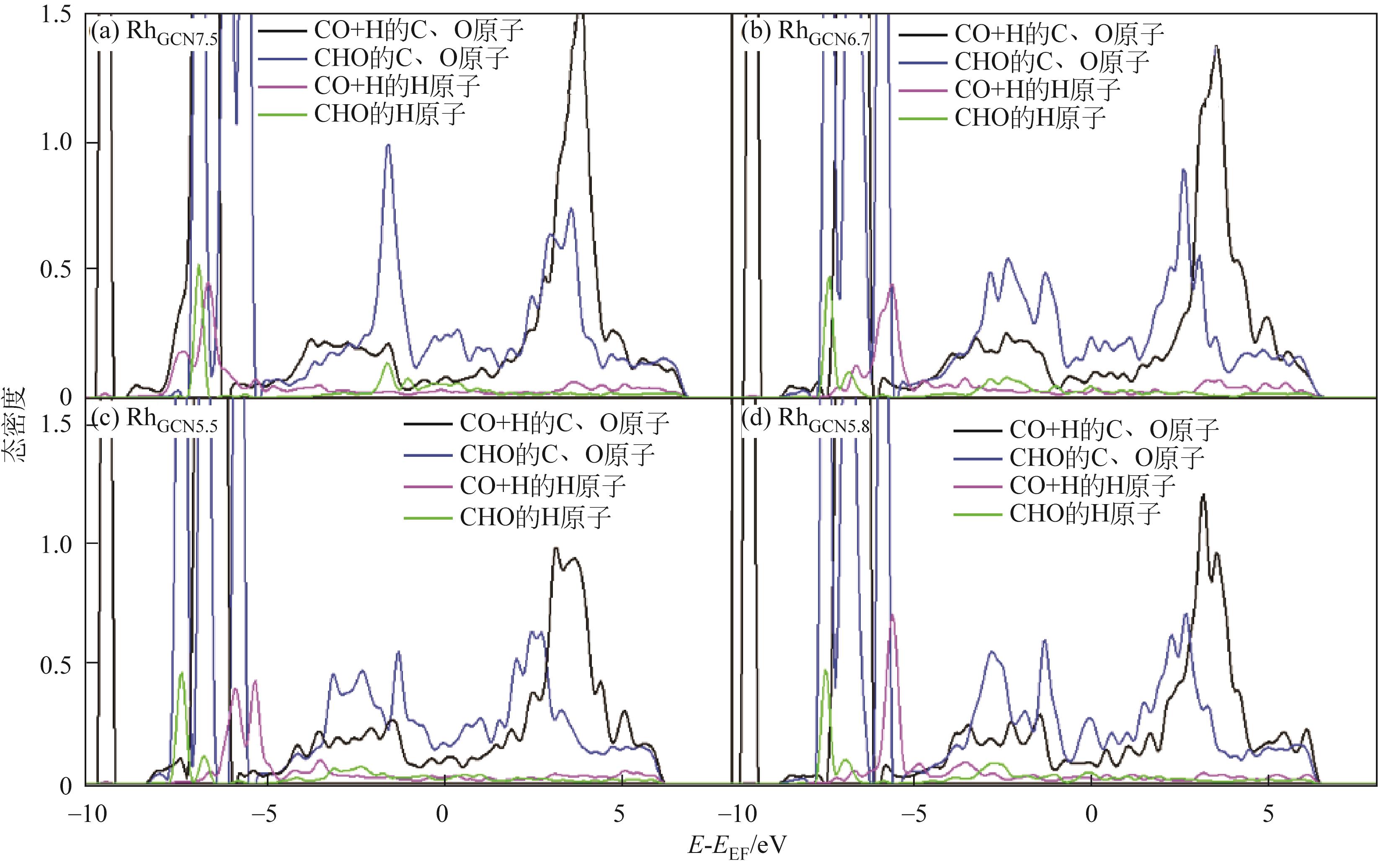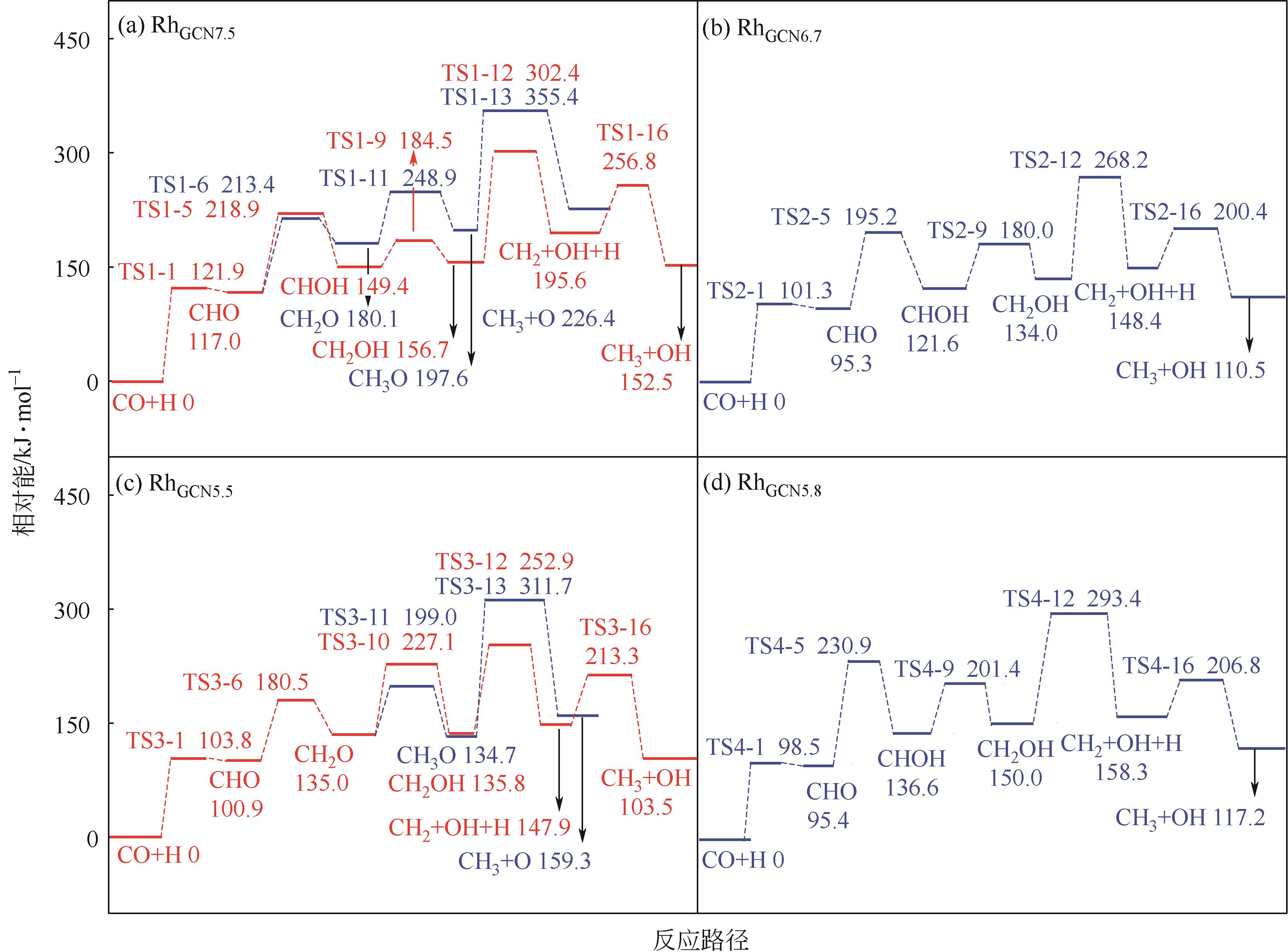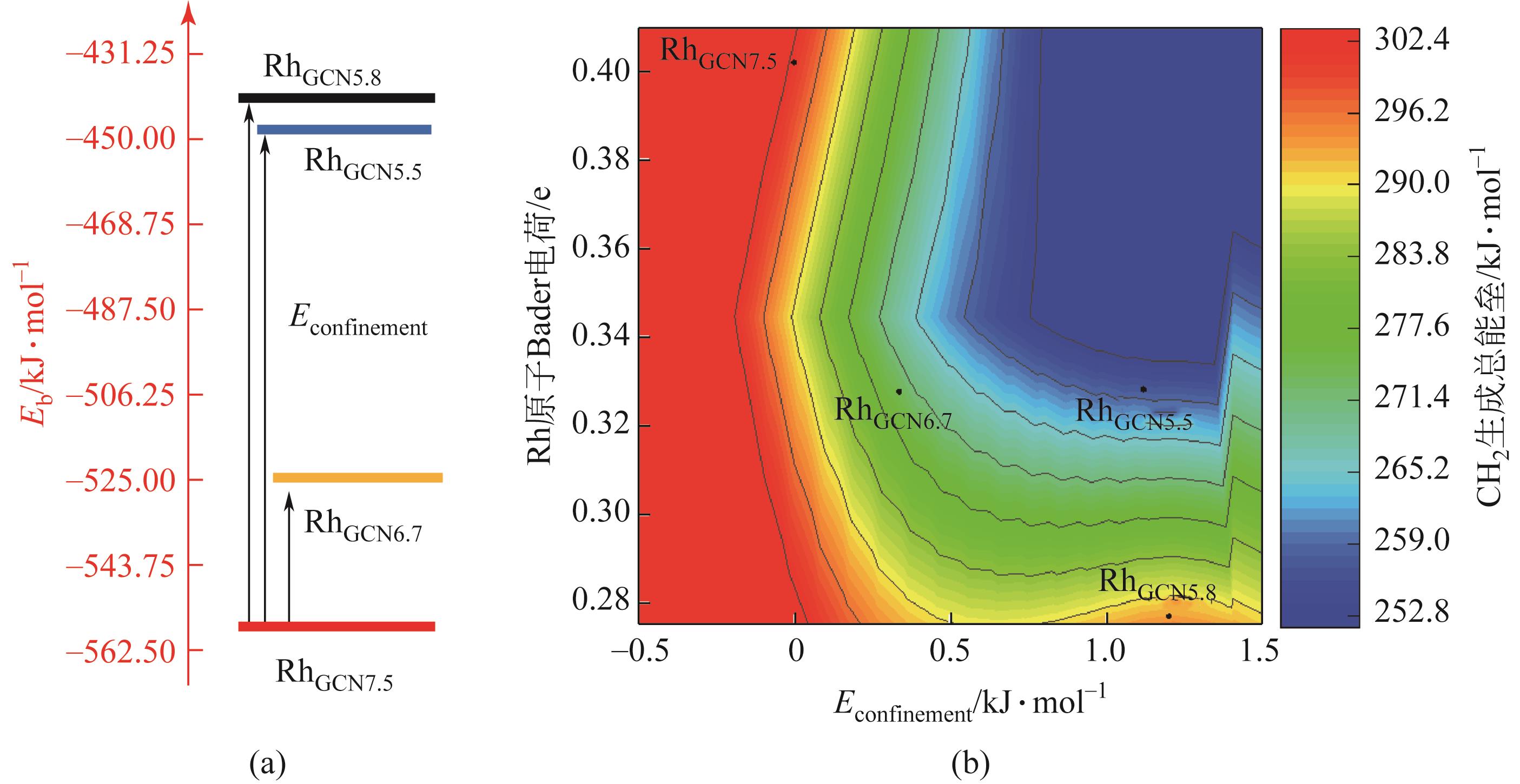化工进展 ›› 2024, Vol. 43 ›› Issue (5): 2684-2695.DOI: 10.16085/j.issn.1000-6613.2023-2179
• 催化与材料技术 • 上一篇
RhCu催化剂中限域环境调控合成气转化生成CH x 反应性能
- 太原理工大学省部共建煤基能源清洁高效利用国家重点实验室,山西 太原 030024
-
收稿日期:2023-12-11修回日期:2024-04-22出版日期:2024-05-15发布日期:2024-06-15 -
通讯作者:章日光 -
作者简介:李娜(1999—),女,博士研究生,研究方向为多相催化基础理论。E-mail:lina0731@link.tyut.edu.cn。 -
基金资助:国家重点研发计划(2021YFA1502804);山西省杰出青年科学基金(202103021221005)
Confined environment of RhCu catalyst to regulate the reaction performance for synthesis gas conversion to CH x
LI Na( ), ZHAO Wantong, LING Lixia, WANG Baojun, ZHANG Riguang(
), ZHAO Wantong, LING Lixia, WANG Baojun, ZHANG Riguang( )
)
- State Key Laboratory of Clean and Efficient Coal Utilization, Taiyuan University of Technology, Taiyuan 030024, Shanxi, China
-
Received:2023-12-11Revised:2024-04-22Online:2024-05-15Published:2024-06-15 -
Contact:ZHANG Riguang
摘要:
合成气制C2含氧化合物的选择性目前仍面临巨大挑战。本研究基于密度泛函理论计算方法,探究了4种RhCu限域催化剂中Rh活性位限域环境对合成气转化生成CH x 反应性能的影响,揭示了RhCu限域催化剂中限域效应调控催化性能的本质。结果表明,RhCu限域催化剂中Rh活性位限域环境能够调控合成气转化生成CH x 的活性和选择性。筛选获得 催化剂具有最高的生成CH x (x=1~3)单体活性,归因于适中的限域效应使得表层原子d带中心远离费米能级,导致CH2OH解离过渡态与RhCu表面之间呈现适当的电子转移,利于CH2OH解离,从而呈现良好的CH x 生成活性。本研究为通过调变单原子限域环境实现调控合成气转化生成C2含氧化合物反应的催化性能提供了理论依据,并为单原子限域金属催化剂设计提供了结构线索。
催化剂具有最高的生成CH x (x=1~3)单体活性,归因于适中的限域效应使得表层原子d带中心远离费米能级,导致CH2OH解离过渡态与RhCu表面之间呈现适当的电子转移,利于CH2OH解离,从而呈现良好的CH x 生成活性。本研究为通过调变单原子限域环境实现调控合成气转化生成C2含氧化合物反应的催化性能提供了理论依据,并为单原子限域金属催化剂设计提供了结构线索。
中图分类号:
引用本文
李娜, 赵婉彤, 凌丽霞, 王宝俊, 章日光. RhCu催化剂中限域环境调控合成气转化生成CH x 反应性能[J]. 化工进展, 2024, 43(5): 2684-2695.
LI Na, ZHAO Wantong, LING Lixia, WANG Baojun, ZHANG Riguang. Confined environment of RhCu catalyst to regulate the reaction performance for synthesis gas conversion to CH x[J]. Chemical Industry and Engineering Progress, 2024, 43(5): 2684-2695.
| 1 | ZHANG Riguang, ZHANG Jin, JIANG Zhao, et al. The cost-effective Cu-based catalysts for the efficient removal of acetylene from ethylene: The effects of Cu valence state, surface structure and surface alloying on the selectivity and activity[J]. Chemical Engineering Journal, 2018, 351: 732-746. |
| 2 | AO Min, PHAM Gia Hung, SUNARSO Jaka, et al. Active centers of catalysts for higher alcohol synthesis from syngas: A review[J]. ACS Catalysis, 2018, 8(8): 7025-7050. |
| 3 | SUN X C, ZHANG R G, WANG B J. Insights into the preference of CH x (x=1—3) formation from CO hydrogenation on Cu(111) surface[J]. Applied Surface Science, 2013, 265: 720-730. |
| 4 | CHOI YongMan, LIU Ping. Mechanism of ethanol synthesis from syngas on Rh(111)[J]. Journal of the American Chemical Society, 2009, 131(36): 13054-13061. |
| 5 | WANG Jiancheng, LIU Zhixue, ZHANG Riguang, et al. Ethanol synthesis from syngas on the stepped Rh(211) surface: Effect of surface structure and composition[J]. Journal of Physical Chemistry C, 2014, 118: 22691-22701. |
| 6 | ZHAO Ning, XU Run, WEI Wei, et al. Cu/Mn/ZrO2 catalyst for alcohol synthesis by Fischer-Tropsch modified elements[J]. Reaction Kinetics and Catalysis Letters, 2002, 75(2): 297-304. |
| 7 | XU Run, WEI Wei, LI Wenhuai, et al. Fe modified CuMnZrO2 catalysts for higher alcohols synthesis from syngas: Effect of calcination temperature[J]. Journal of Molecular Catalysis A: Chemical, 2005, 234(1/2): 75-83. |
| 8 | YAN Huan, ZHAO Xiaoxu, GUO Na, et al. Atomic engineering of high-density isolated Co atoms on graphene with proximal-atom controlled reaction selectivity[J]. Nature Communications, 2018, 9: 3197. |
| 9 | Maria FLYTZANI-STEPHANOPOULOS. Gold atoms stabilized on various supports catalyze the water-gas shift reaction[J]. Accounts of Chemical Research, 2014, 47(3): 783-792. |
| 10 | HE Xiaohui, HE Qian, DENG Yuchen, et al. A versatile route to fabricate single atom catalysts with high chemoselectivity and regioselectivity in hydrogenation[J]. Nature Communications, 2019, 10: 3663. |
| 11 | LI Xinle, Tian Wei GOH, LI Lei, et al. Controlling catalytic properties of Pd nanoclusters through their chemical environment at the atomic level using isoreticular metal-organic frameworks[J]. ACS Catalysis, 2016, 6(6): 3461-3468. |
| 12 | PAN Yuan, CHEN Yinjuan, WU Konglin, et al. Regulating the coordination structure of single-atom Fe-N x C y catalytic sites for benzene oxidation[J]. Nature Communications, 2019, 10: 4290. |
| 13 | LI Siwei, XU Yao, CHEN Yifu, et al. Tuning the selectivity of catalytic carbon dioxide hydrogenation over iridium/cerium oxide catalysts with a strong metal-support interaction[J]. Angewandte Chemie (International Ed in English), 2017, 56(36): 10761-10765. |
| 14 | FU Qiang, LUO Yi. Active sites of Pd-doped flat and stepped Cu(111) surfaces for H2 dissociation in heterogeneous catalytic hydrogenation[J]. ACS Catalysis, 2013, 3(6): 1245-1252. |
| 15 | QI Yamin, WANG Baojun, FAN Maohong, et al. C2H2 semi-hydrogenation on the metal M (M=Cu, Ag, Au) alloyed single-atom Pd catalysts: Effects of Pd coordination number and environment on the catalytic performance[J]. Chemical Engineering Science, 2021, 243: 116786. |
| 16 | SOLYMOSI F, CSERÉNYI J. Enhanced formation of ethane in the conversion of methane over Cu-Rh/SiO2 [J]. Catalysis Letters, 1995, 34(3): 343-350. |
| 17 | ZHAO Yonghui, YANG Mingmei, SUN Dapeng, et al. Rh-decorated Cu alloy catalyst for improved C2 oxygenate formation from syngas[J]. The Journal of Physical Chemistry C, 2011, 115(37): 18247-18256. |
| 18 | BAO Zhenghong, XIAO Kang, QI Xingzhen, et al. Higher alcohol synthesis over Cu-Fe composite oxides with high selectivity to C2+ OH[J]. Journal of Energy Chemistry, 2013, 22(1): 107-113. |
| 19 | WANG Baojun, GUO Weisheng, ZHANG Riguang, et al. C2 oxygenates formation from syngas over the Cu-rich and Rh-rich surfaces of Rh-Cu bimetallic catalysts: Probing into the effects of the surface structure and composition on the catalytic performance[J]. The Journal of Physical Chemistry C, 2019, 123(32): 19528-19539. |
| 20 | ZHANG Riguang, WANG Guiru, WANG Baojun. Insights into the mechanism of ethanol formation from syngas on Cu and an expanded prediction of improved Cu-based catalyst[J]. Journal of Catalysis, 2013, 305: 238-255. |
| 21 | LI Zhiyuan, LI Na, WANG Nan, et al. Mechanism investigations on water gas shift reaction over Cu(111), Cu(100), and Cu(211) surfaces[J]. ACS Omega, 2022, 7(4): 3514-3521. |
| 22 | CAO Kun, Füchsel Gernot, KLEYN Aart W, et al. Hydrogen adsorption and desorption from Cu(111) and Cu(211)[J]. Physical Chemistry Chemical Physics: PCCP, 2018, 20(35): 22477-22488. |
| 23 | DELLEY B. An all-electron numerical method for solving the local density functional for polyatomic molecules[J]. The Journal of Chemical Physics, 1990, 92(1): 508-517. |
| 24 | DELLEY B. From molecules to solids with the DMol3 approach[J]. The Journal of Chemical Physics, 2000, 113(18): 7756-7764. |
| 25 | PERDEW J P, CHEVARY J A, VOSKO S H, et al. Atoms, molecules, solids, and surfaces: Applications of the generalized gradient approximation for exchange and correlation[J]. Physical Review B, Condensed Matter, 1992, 46(11): 6671-6687. |
| 26 | HAMMER Bjørk, HANSEN Lars Bruno, NØRSKOV Jens K. Improved adsorption energetics within density-functional theory using revised Perdew-Burke-Ernzerhof functionals[J]. \prb, 1999, 59(11): 7413-7421. |
| 27 | DOLG Michael, WEDIG Ulrich, STOLL Hermann, et al. Energy-adjusted ab initio pseudopotentials for the first row transition elements[J]. The Journal of Chemical Physics, 1987, 86: 866-872. |
| 28 | TIAN Dongxu, ZHANG Hualei, ZHAO Jijun. Structure and structural evolution of Ag n (n=3—22) clusters using a genetic algorithm and density functional theory method[J]. Solid State Communications, 2007, 144(3/4): 174-179. |
| 29 | HALGREN Thomas A, LIPSCOMB William N. The synchronous-transit method for determining reaction pathways and locating molecular transition states[J]. Chemical Physics Letters, 1977, 49(2): 225-232. |
| 30 | MEDFORD Andrew J, LAUSCHE Adam C, Frank ABILD-PEDERSEN, et al. Activity and selectivity trends in synthesis gas conversion to higher alcohols[J]. Topics in Catalysis, 2014, 57(1): 135-142. |
| 31 | CALLE-VALLEJO F, MARTÍNEZ J I, GARCÍA-LASTRA J M, et al. Fast prediction of adsorption properties for platinum nanocatalysts with generalized coordination numbers[J]. Angewandte Chemie International Edition, 2014, 53(32): 8316-8319. |
| 32 | ZHAO Zhonglong, CHEN Zhengzheng, ZHANG Xu, et al. Generalized surface coordination number as an activity descriptor for CO2 reduction on Cu surfaces[J]. The Journal of Physical Chemistry C, 2016, 120(49): 28125-28130. |
| 33 | VERGA Lucas G, MENDES Paulo C D, OCAMPO-RESTREPO Vivianne K, et al. Exploring the adsorption site coordination as a strategy to tune copper catalysts for CO2 electro-reduction[J]. Catalysis Science & Technology, 2022, 12(3): 869-879. |
| 34 | WEI Cong, ZHANG Riguang, LING Lixia, et al. Syngas-to-C2 oxygenates on Cu-based catalyst: Quantitative insight into the balancing effect of active Cu δ +(0≤δ≤1) sites[J]. Chemical Engineering Science, 2020, 224: 115785. |
| 35 | ZHANG Riguang, WEI Cong, LI Debao, et al. The new role of surface adsorbed CH (x=1—3) intermediates as a co-adsorbed promoter in self-promoting syngas conversion to form CH intermediates and C2 oxygenates on the Rh-doped Cu catalyst[J]. Journal of Catalysis, 2019, 377: 1-12. |
| 36 | CHEN Dachang, CHEN Zhiwen, LU Zhuole, et al. Computational screening of homo and hetero transition metal dimer catalysts for reduction of CO2 to C2 products with high activity and low limiting potential[J]. Journal of Materials Chemistry A, 2020, 8(40): 21241-21254. |
| 37 | NING Yanxiao, WEI Mingming, YU Liang, et al. Nature of interface confinement effect in oxide/metal catalysts[J]. The Journal of Physical Chemistry C, 2015, 119(49): 27556-27561. |
| 38 | HAMMER B, NØRSKOV J K. Electronic factors determining the reactivity of metal surfaces[J]. Surface Science, 1995, 343(3): 211-220. |
| [1] | 王嘉锐, 刘大伟, 邓耀, 徐瑾, 马晓迅, 徐龙. 载氧体在甲烷化学链重整反应中的研究进展[J]. 化工进展, 2024, 43(5): 2235-2253. |
| [2] | 刘显哲, 胡振中, 胡大为, 李显, 贺世泽, 赵纯亮, 夏慈良, 吴波, 张小勇, 罗光前, 姚洪. 低阶煤热溶萃取物的配煤炼焦性能[J]. 化工进展, 2024, 43(5): 2420-2427. |
| [3] | 王欣宇, 王超, 张梦娟, 刘方正, 李晗旸, 王正林, 贾鑫, 宋兴飞, 许光文, 韩振南. 松木颗粒流态化两段气化制备清洁燃气的工艺稳定性验证[J]. 化工进展, 2024, 43(5): 2576-2586. |
| [4] | 成昊霖, 年瑶, 韩优. CH4和CO2共转化反应机理研究进展[J]. 化工进展, 2024, 43(1): 60-75. |
| [5] | 杨霞珍, 彭伊凡, 刘化章, 霍超. 熔铁催化剂活性相的调控及其费托反应性能[J]. 化工进展, 2023, 42(S1): 310-318. |
| [6] | 陆洋, 周劲松, 周启昕, 王瑭, 刘壮, 李博昊, 周灵涛. CeO2/TiO2吸附剂煤气脱汞产物的浸出规律[J]. 化工进展, 2023, 42(7): 3875-3883. |
| [7] | 田园, 娄舒洁, 孟闪茹, 闫敬如, 肖海成. 合成气制高碳醇钴基催化剂研究进展[J]. 化工进展, 2023, 42(4): 1869-1876. |
| [8] | 阮鹏, 杨润农, 林梓荣, 孙永明. 甲烷催化部分氧化制合成气催化剂的研究进展[J]. 化工进展, 2023, 42(4): 1832-1846. |
| [9] | 郑云武, 裴涛, 李冬华, 王继大, 李继容, 郑志锋. 金属氧化物活化P/HZSM-5催化生物质热解气重整制备富烃生物油[J]. 化工进展, 2023, 42(3): 1353-1364. |
| [10] | 胡鹏, 赵丹, 纪红兵. 温控构筑仿生契合辨识机制强化合成气提纯[J]. 化工进展, 2023, 42(12): 6133-6135. |
| [11] | 米泽豪, 花儿. 多元胺-TFSA型质子化离子液体吸收CO2的理论分析[J]. 化工进展, 2023, 42(11): 6015-6030. |
| [12] | 李婉麒, 杨凤娟, 贾德臣, 姜卫红, 顾阳. 合成气的生物利用与定向转化[J]. 化工进展, 2023, 42(1): 73-85. |
| [13] | 邓少碧, 边洲峰. 核壳结构在甲烷干重整中的应用[J]. 化工进展, 2023, 42(1): 247-254. |
| [14] | 张大洲, 卢文新, 商宽祥, 胡媛, 朱凡, 张宗飞. 草酸二甲酯加氢制乙醇酸甲酯反应网络分析及其多相加氢催化剂研究进展[J]. 化工进展, 2023, 42(1): 204-214. |
| [15] | 石轩, 杨东元, 胡浩斌, 王焦飞, 张壮壮, 贺建勋, 代成义, 马晓迅. 苯与合成气在ZnAlCrO x &HZSM-5双功能催化剂上一步法制甲苯/二甲苯[J]. 化工进展, 2022, 41(S1): 247-259. |
| 阅读次数 | ||||||
|
全文 |
|
|||||
|
摘要 |
|
|||||
